Effect of Tool Rotational Speeds on the Microstructure and Mechanical Properties of a Dissimilar Friction-Stir-Welded CuCrZr/CuNiCrSi Butt Joint
Abstract
:1. Introduction
2. Materials and Methods
2.1. Friction-Stir-Welding Process
2.2. Microstructural Characterization
2.3. Mechanical Testing
3. Results
3.1. Surface Morphologies and X-ray Radiographs of the Joints
3.2. Microstructure of Dissimilar CuCrZr/CuNiCrSi Butt Joints
3.3. Mechanical Properties of CuCrZr/CuNiCrSi Butt Joints
4. Discussion
4.1. Effect of Rotational Speeds on the Formation of Welds
4.2. Effects of Rotational Speeds on the Microstructure of Joints
4.3. Effects of Rotational Speeds on the Mechanical Properties of Joints
- (1)
- Regarding the strengthening mechanisms of the BM, the grain boundary strengthening is limited due to the large grain size in the BM, which can reach up to 30–50 µm. However, the CuCrZr-BM contains a large density of Cr precipitates, while a great deal of Cr and δ-Ni2Si precipitates can be detected in the CuNiCrSi-BM, which can contribute a strong precipitation strengthening effect by hindering the movements of dislocations.
- (2)
- For the strengthening mechanisms of the NZ, on the one hand, all precipitates distributed in the BM are dissolved into the matrix in the NZ. The precipitation strengthening cannot work in the NZ. On the other hand, the grain size in the NZ is small when compared with that in the BM. In this case, the grain boundary strengthening plays a dominant impact on the mechanical properties in the NZ. Because the grain size in the NZ increases with the increasing of the rotational speeds, mechanical properties such as microhardness and tensile strength in the NZ decrease when the rotational speed increases from 1400 rpm to 1700 rpm.
5. Conclusions
- (I)
- Dissimilar joints without any defects are obtained at rotational speeds of 1400 and 1700 rpm. Groove-like defects and tunneling defects are formed along the weld line at the lower rotational speeds of 800 and 1100 rpm. However, surface-galling defects are seen to occur at the higher rotational speed of 2100 rpm.
- (II)
- The area of retreating materials and the grain size in the NZ increases with the increasing of rotational speeds. The CuNiCrSi-BM contains a large density of Cr and δ-Ni2Si precipitates, while a great deal of Cr precipitates is detected in the CuCrZr-BM. All these precipitates are completely dissolved into the NZ as a consequence of high welding speed.
- (III)
- Precipitation strengthening plays a dominant role in the BM. Both hardness and tensile strength decrease sharply from the BM to the NZ due to the dissolution of precipitates. Grain boundary strengthening plays a dominant impact on the mechanical properties in the NZ. Mechanical properties such as microhardness and tensile strength in the NZ decrease with the rotational speed increasing.
- (IV)
- The CuCrZr-NZ is the softest zone in the whole joint. The fracture location of the tensile specimens is the CuCrZr-NZ with the CuNiCrSi alloy fixed on the AS, but the tensile specimens failed at the mixed zone of the two alloys when CuNiCrSi was on the RS.
Author Contributions
Funding
Acknowledgments
Conflicts of Interest
References
- Ahmed, M.M.Z.; Ataya, S.; El-Sayed Seleman, M.M.; Ammar, H.R.; Ahmed, E. Friction stir welding of similar and dissimilar AA7075 and AA5083. J. Mater. Process. Technol. 2017, 242, 77–91. [Google Scholar] [CrossRef]
- Sun, Y.F.; Fujii, H. Investigation of the welding parameter dependent microstructure and mechanical properties of friction stir welded pure copper. Mater. Sci. Eng. A 2010, 527, 6879–6886. [Google Scholar] [CrossRef]
- Liu, H.J.; Shen, J.J.; Huang, Y.X.; Kuang, L.Y.; Liu, C.; Li, C. Effect of tool rotation rate on microstructure and mechanical properties of friction stir welded copper. Sci. Technol. Weld. Join. 2009, 14, 577–583. [Google Scholar] [CrossRef]
- Azizi, A.; Barenji, R.V.; Barenji, A.V.; Hashemipour, M. Microstructure and mechanical properties of friction stir welded thick pure copper plates. Int. J. Adv. Manuf. Technol. 2016, 86, 1985–1995. [Google Scholar] [CrossRef]
- Zhang, Q.Z.; Gong, W.B.; Liu, W. Microstructure and mechanical properties of dissimilar Al-Cu joints by friction stir welding. Trans. Nonferr. Met. Soc. China 2015, 25, 1779–1786. [Google Scholar] [CrossRef]
- Xue, P.; Ni, D.R.; Wang, D.; Xiao, B.L.; Ma, Z.Y. Effect of friction stir welding parameters on the microstructure and mechanical properties of the dissimilar Al–Cu joints. Mater. Sci. Eng. A 2011, 528, 4683–4689. [Google Scholar] [CrossRef]
- Tan, C.W.; Jiang, Z.G.; Li, L.Q.; Chen, Y.B.; Chen, X.Y. Microstructural evolution and mechanical properties of dissimilar Al–Cu joints produced by friction stir welding. Mater. Des. 2013, 51, 466–473. [Google Scholar] [CrossRef]
- Sahu, P.K.; Pal, S.; Pal, S.K.; Jain, R. Influence of plate position, tool offset and tool rotational speed on mechanical properties and microstructures of dissimilar Al/Cu friction stir welding joints. J. Mater. Process. Technol. 2016, 235, 55–67. [Google Scholar] [CrossRef]
- Mishnev, R.; Shakhova, I.; Belyakov, A.; Kaibyshev, R. Deformation microstructures, strengthening mechanisms, and electrical conductivity in a Cu–Cr–Zr alloy. Mater. Sci. Eng. A 2015, 629, 29–40. [Google Scholar] [CrossRef]
- Gholami, M.; Vesely, J.; Altenberger, I.; Kuhn, H.A.; Janecek, M.; Wollmann, M.; Wagner, L. Effects of microstructure on mechanical properties of CuNiSi alloys. J. Alloys Compd. 2017, 696, 201–212. [Google Scholar] [CrossRef]
- Shueh, C.; Chan, C.K.; Chang, C.C.; Sheng, I.C. Investigation of vacuum properties of CuCrZr alloy for high-heat-load absorber. Nucl. Instrum. Methods Phys. Res. 2017, 841, 1–4. [Google Scholar] [CrossRef]
- Lipa, M.; Durocher, A.; Tivey, R.; Huber, T.; Schedler, B.; Weigert, J. The use of copper alloy CuCrZr as a structural material for actively cooled plasma facing and in vessel components. Fusion Eng. Des. 2005, 75, 469–473. [Google Scholar] [CrossRef]
- Sahlot, P.; Jha, K.; Dey, G.K.; Arora, A. Quantitative wear analysis of H13 steel tool during friction stir welding of Cu-0.8%Cr-0.1%Zr alloy. Wear 2017, 378–379, 82–89. [Google Scholar] [CrossRef]
- Jha, K.; Kumar, S.; Nachiket, K.; Bhanumurthy, K.; Dey, G.K. Friction stir welding (FSW) of aged CuCrZr alloy plates. Metall. Mater. Trans. A 2018, 49, 223–234. [Google Scholar] [CrossRef]
- Lai, R.; He, D.; He, G.; Lin, J.; Sun, Y. Study of the microstructure evolution and properties response of a friction-stir-welded copper-chromium-zirconium alloy. Metals 2017, 7, 381. [Google Scholar] [CrossRef]
- Sun, Y.; He, D.; Xue, F.; Lai, R.; He, G. Microstructure and mechanical characterization of a dissimilar friction-stir-welded CuCrZr/CuNiCrSi butt joint. Metals 2018, 8, 325. [Google Scholar] [CrossRef]
- Holzwarth, U.; Stamm, H. The precipitation behaviour of ITER-grade Cu–Cr–Zr alloy after simulating the thermal cycle of hot isostatic pressing. J. Nucl. Mater. 2000, 279, 31–45. [Google Scholar] [CrossRef]
- Lei, Q.; Xiao, Z.; Hu, W.; Derby, B.; Li, Z. Phase transformation behaviors and properties of a high strength Cu-Ni-Si alloy. Mater. Sci. Eng. A 2017, 697, 37–47. [Google Scholar] [CrossRef]
- Lockyer, S.A.; Noble, F.W. Precipitate structure in a Cu-Ni-Si alloy. J. Mater. Sci. 1994, 29, 218–226. [Google Scholar] [CrossRef]
- Mishra, R.S.; Ma, Z.Y. Friction stir welding and processing. Mater. Sci. Eng. R 2005, 50, 1–78. [Google Scholar] [CrossRef]
- Zoeram, A.S.; Anijdan, S.H.M.; Jafarian, H.R.; Bhattacharjee, T. Welding parameters analysis and microstructural evolution of dissimilar joints in Al/Bronze processed by friction stir welding and their effect on engineering tensile behavior. Mater. Sci. Eng. A 2017, 687, 288–297. [Google Scholar] [CrossRef]
- Ajri, A.; Shin, Y.C. Investigation on the effects of process parameters on defect formation in friction stir welded samples via predictive numerical modeling and experiments. J. Manuf. Sci. Eng. 2017, 139, 111009. [Google Scholar] [CrossRef]
- Zettler, R.; Vugrin, T.; Schmücker, M. Effects and defects of friction stir welds. Frict. Stir Weld. 2010, 23, 245–276. [Google Scholar]
- Zhu, Y.; Chen, G.; Chen, Q.; Zhang, G.; Shi, Q. Simulation of material plastic flow driven by non-uniform friction force during friction stir welding and related defect prediction. Mater. Des. 2016, 108, 400–410. [Google Scholar] [CrossRef]
- Guo, J.F.; Chen, H.C.; Sun, C.N.; Bi, G.; Sun, Z.; Wei, J. Friction stir welding of dissimilar materials between AA6061 and AA7075 Al alloys effects of process parameters. Mater. Des. 2014, 56, 185–192. [Google Scholar] [CrossRef]
- Sato, Y.S.; Kokawa, H.; Enomoto, M.; Jogan, S. Microstructural evolution of 6063 aluminum during friction-stir welding. Metall. Mater. Trans. A 1999, 30, 2429–2437. [Google Scholar] [CrossRef]
- Rhodes, C.G.; Mahoney, M.W.; Bingel, W.H.; Spurling, R.A.; Bampton, C.C. Effects of friction stir welding on microstructure of 7075 aluminum. Scr. Mater. 1997, 36, 69–75. [Google Scholar] [CrossRef]
- Ma, K.; Wen, H.; Hu, T.; Topping, T.D.; Isheim, D.; Seidman, D.N.; Lavernia, E.J.; Schoenung, J.M. Mechanical behavior and strengthening mechanisms in ultrafine grain precipitation-strengthened aluminum alloy. Acta Mater. 2014, 62, 141–155. [Google Scholar] [CrossRef]

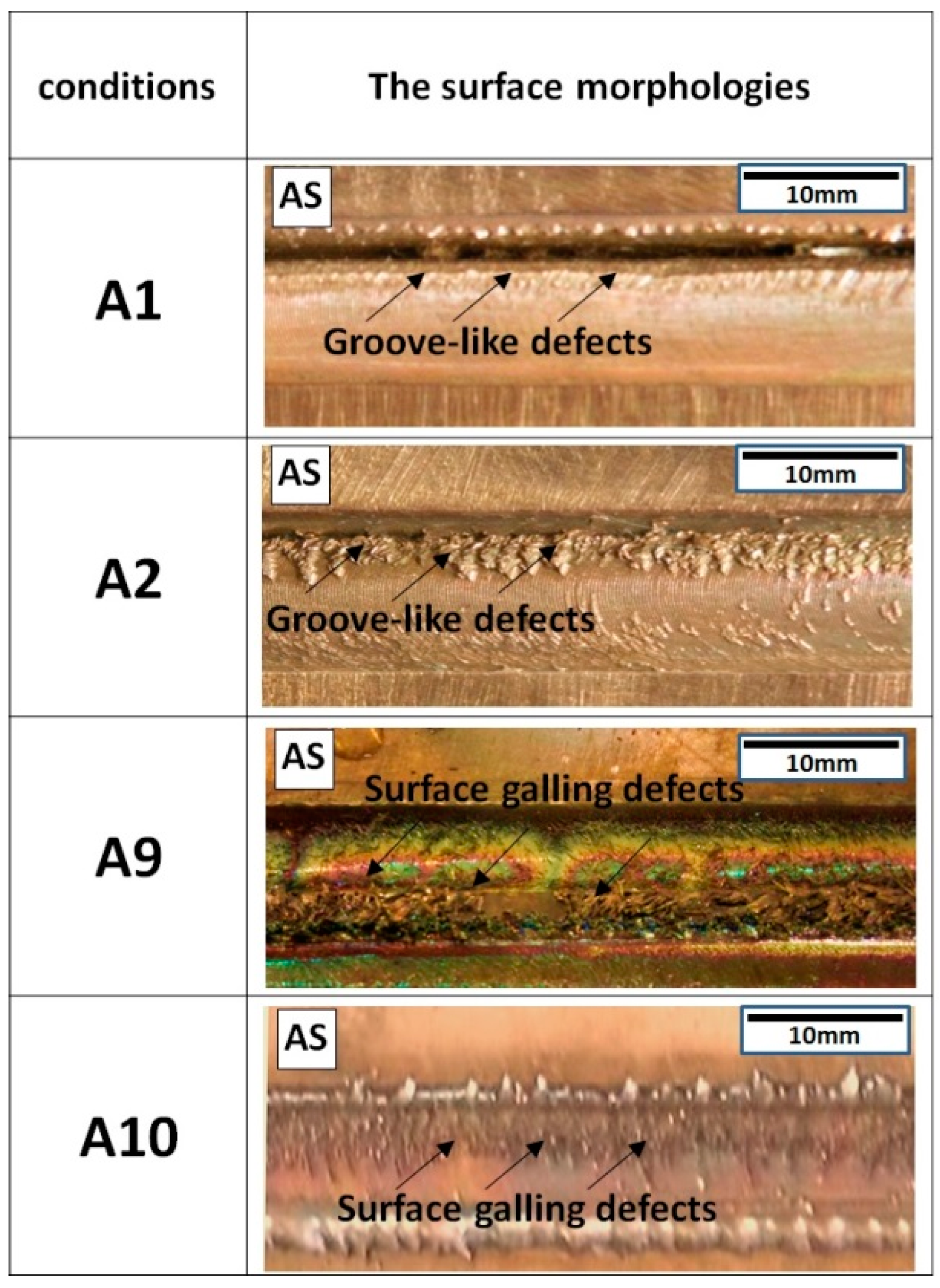
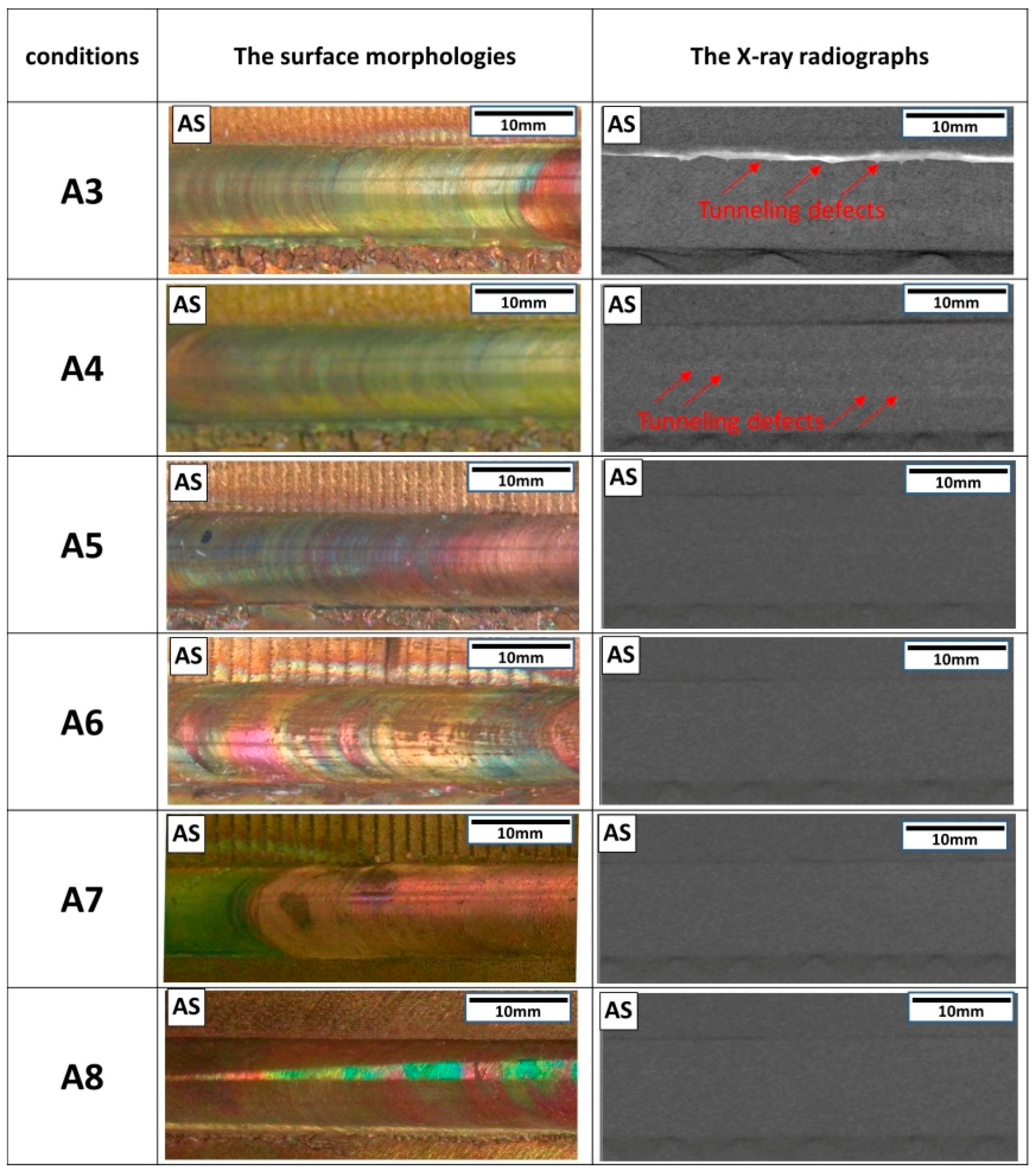
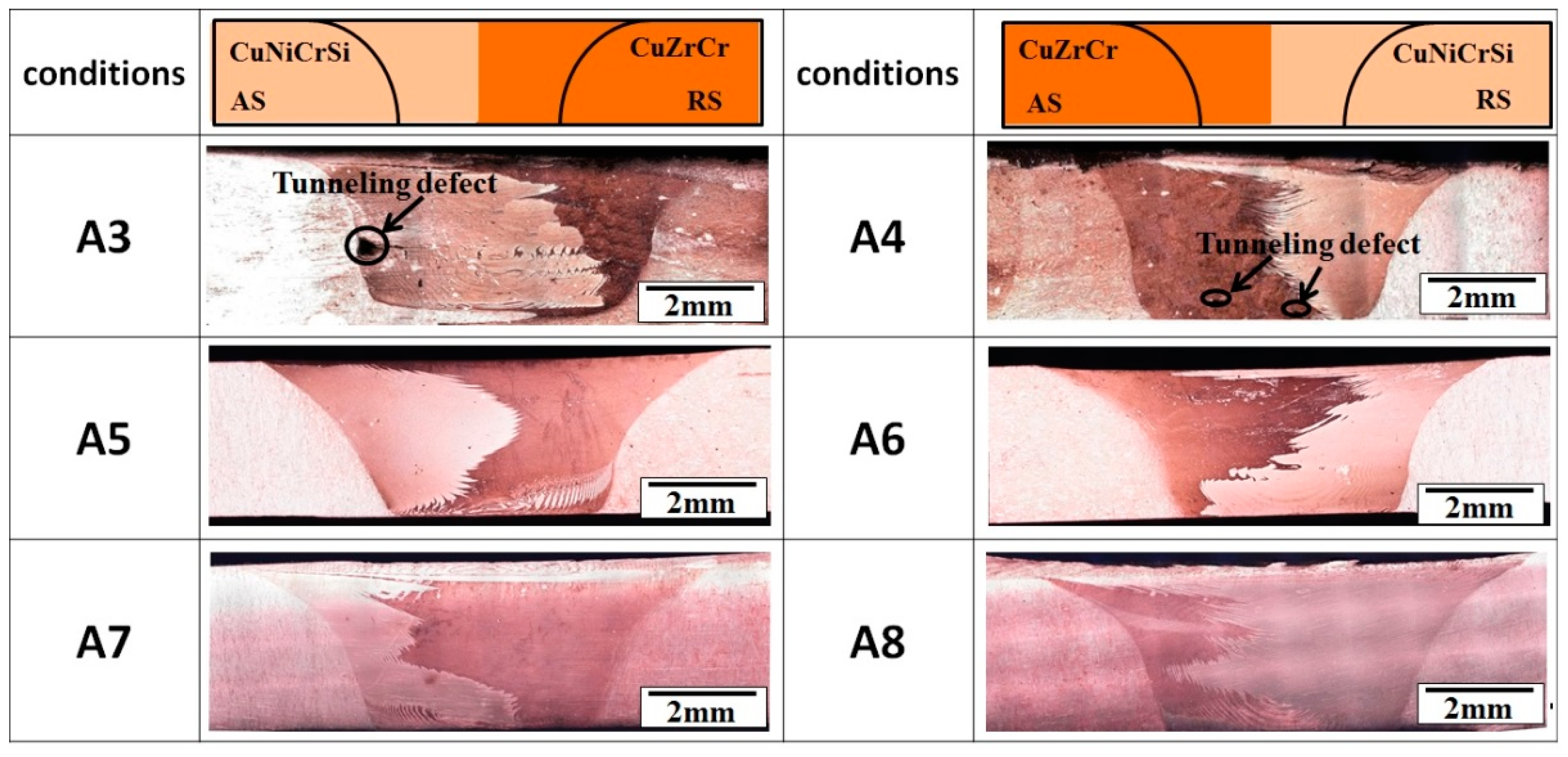
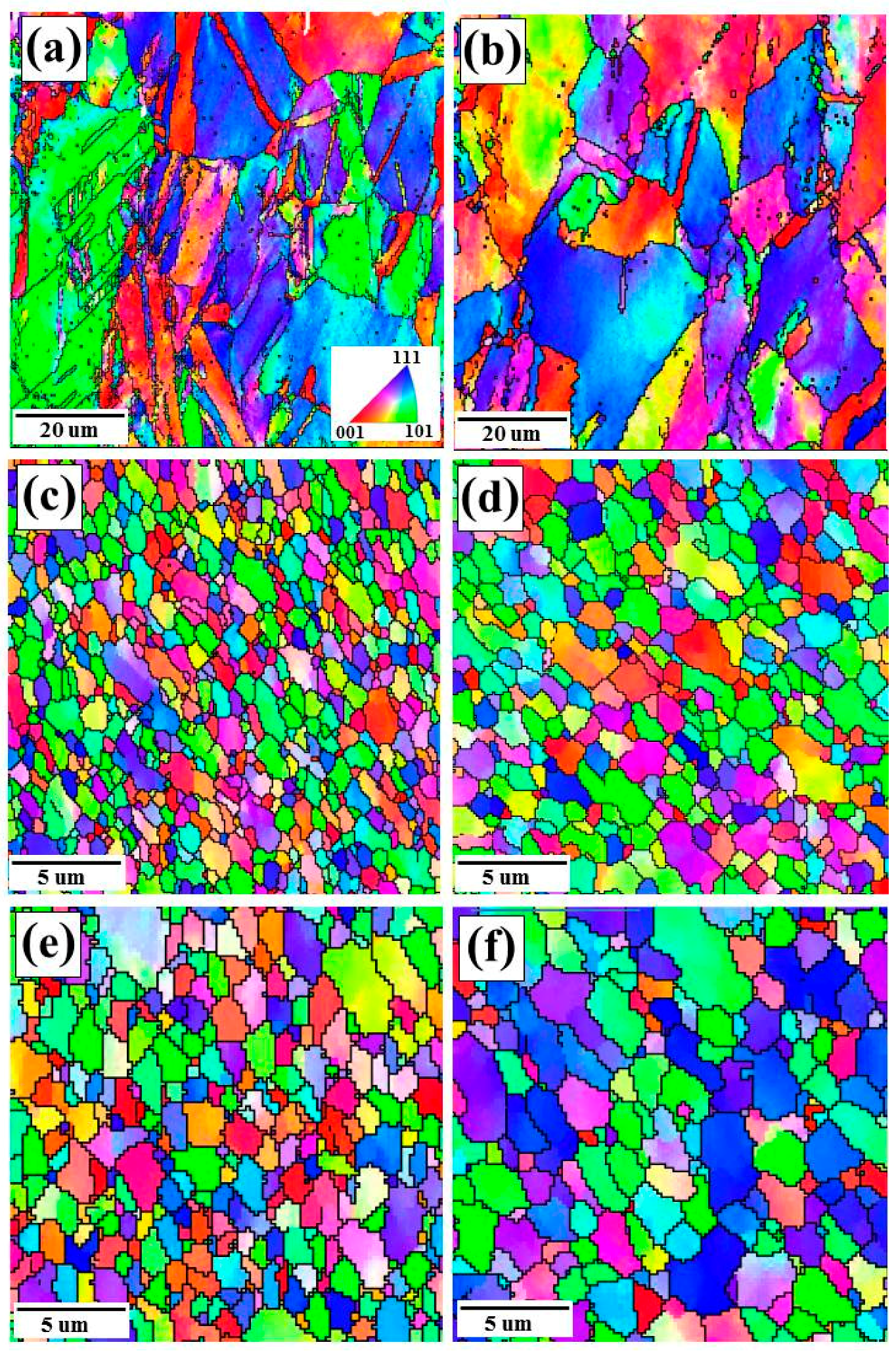
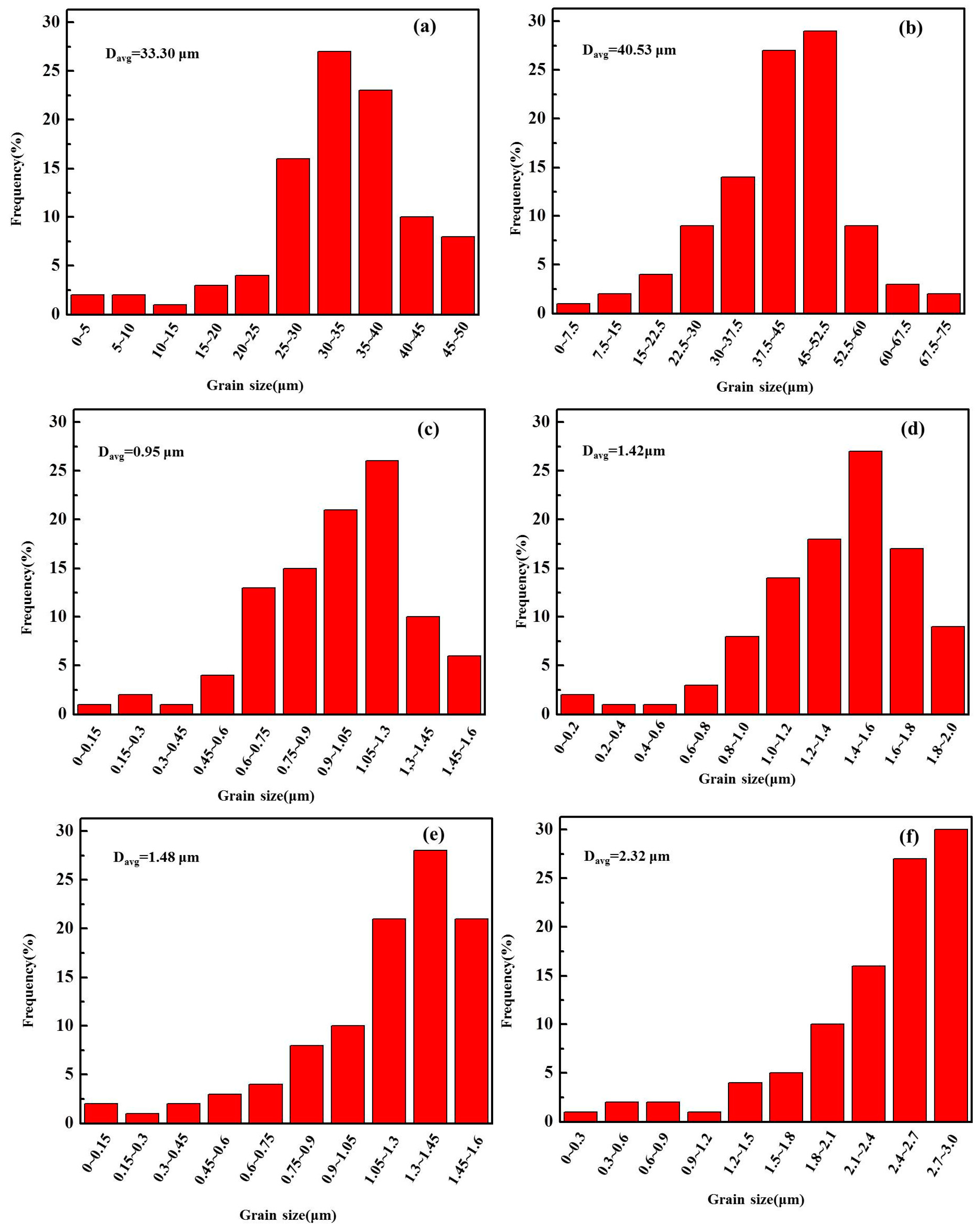

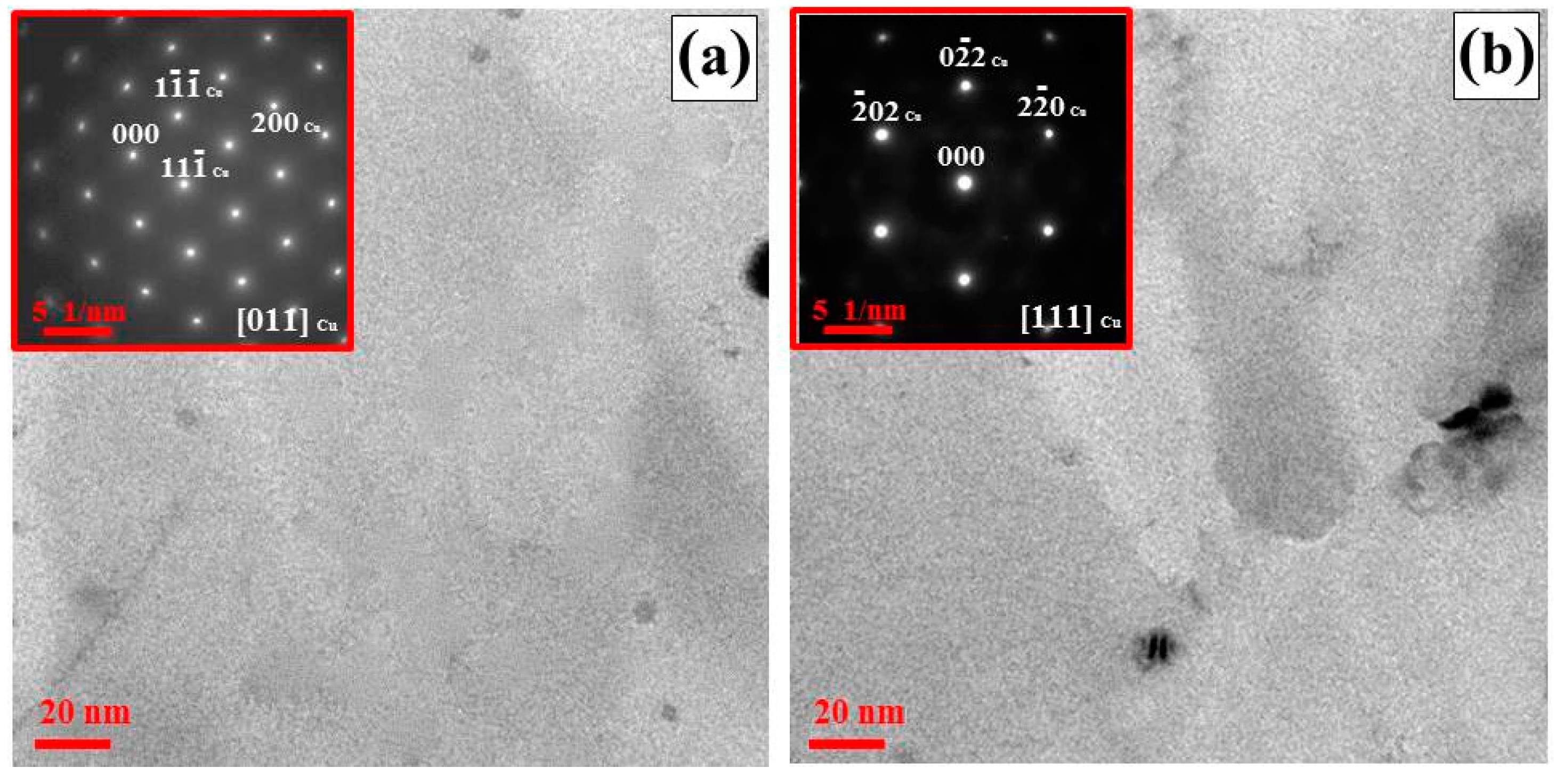
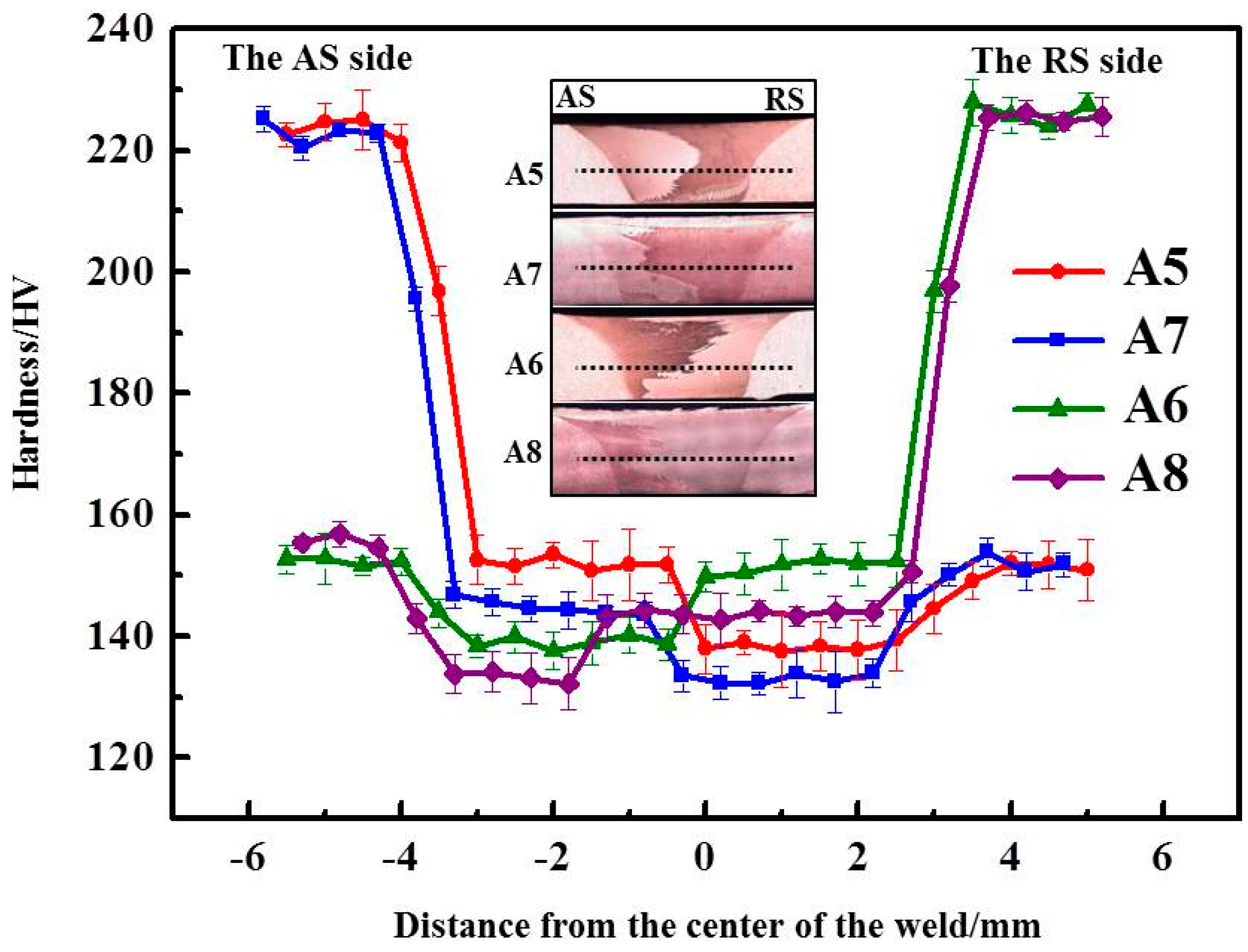
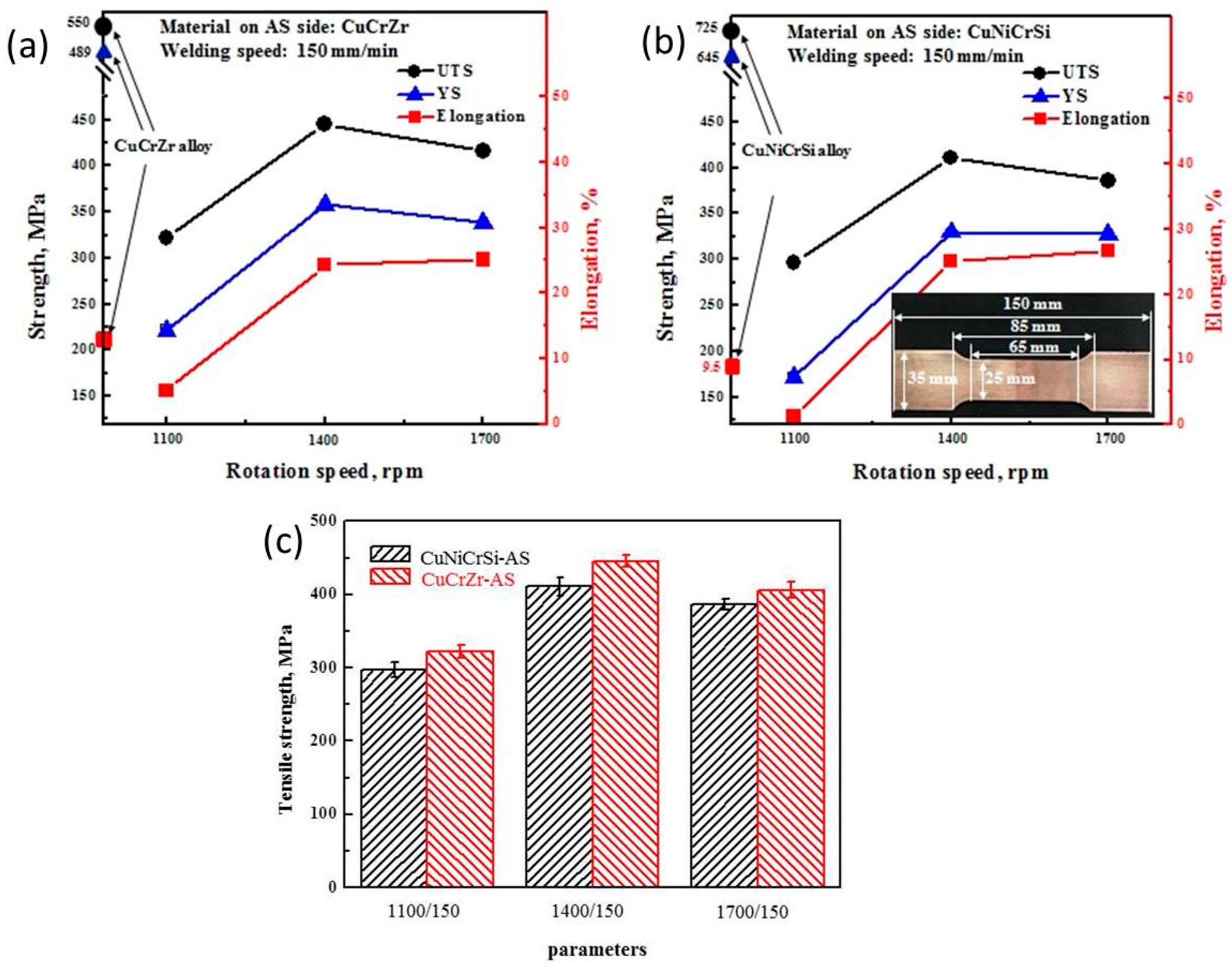
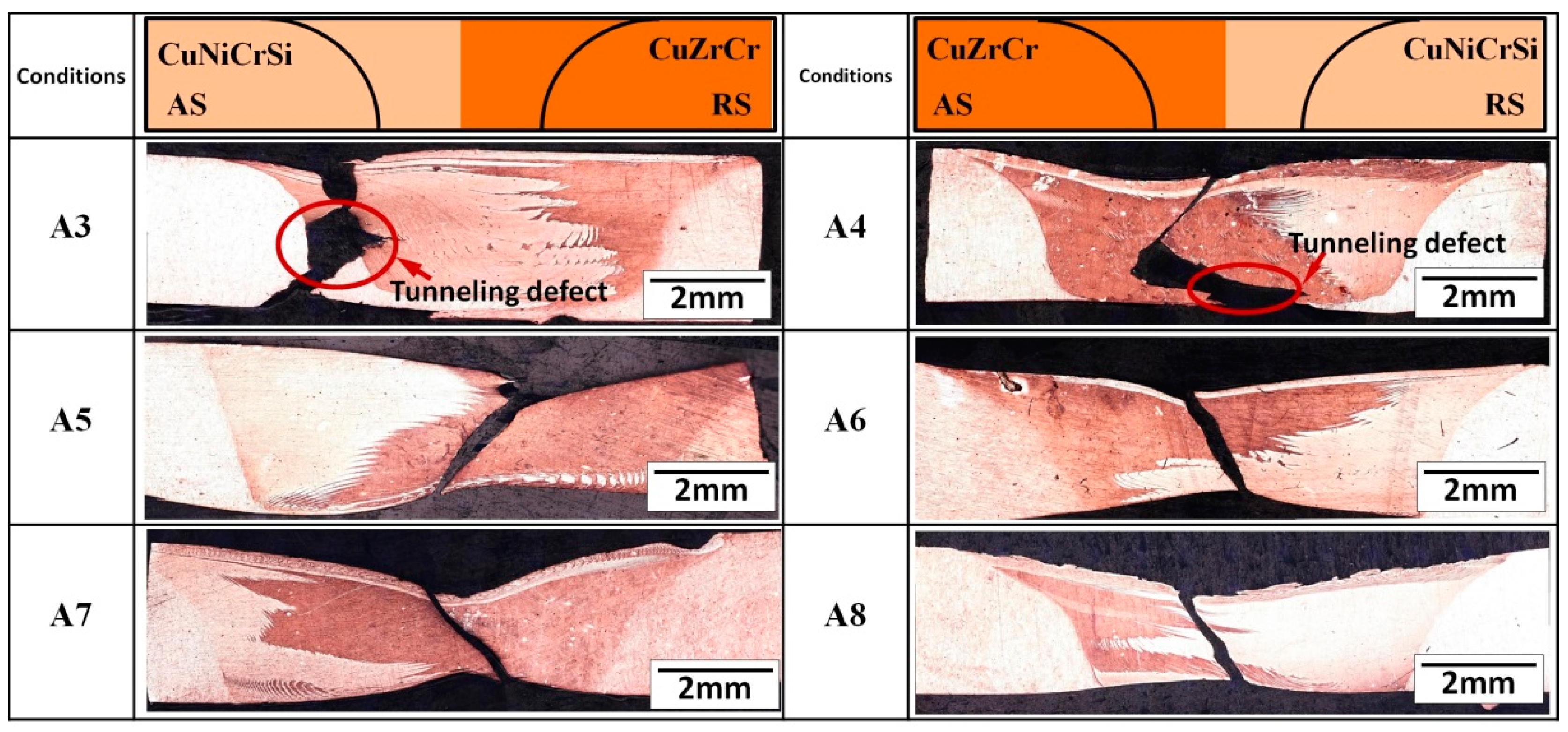

| Alloy (wt %) | Cu | Al | Mg | Cr | Ni | Zr | Fe | Si |
|---|---|---|---|---|---|---|---|---|
| CuCrZr | Bal. | 0.25 | 0.1 | 0.8 | - | 0.3 | 0.09 | 0.04 |
| CuNiCrSi | Bal. | - | - | 0.5 | 2.0 | - | ≤0.15 | 0.5 |
| Conditions | Material on the Advancing Side (AS) | Material on the Retreating Side (RS) | Rotational Speeds (rpm) | Travel Speed (mm/s) | Tilt Angle (°) |
|---|---|---|---|---|---|
| A1 | CuNiCrSi | CuCrZr | 800 | 150 | 2.5 |
| A2 | CuCrZr | CuNiCrSi | 800 | 150 | 2.5 |
| A3 | CuNiCrSi | CuCrZr | 1100 | 150 | 2.5 |
| A4 | CuCrZr | CuNiCrSi | 1100 | 150 | 2.5 |
| A5 | CuNiCrSi | CuCrZr | 1400 | 150 | 2.5 |
| A6 | CuCrZr | CuNiCrSi | 1400 | 150 | 2.5 |
| A7 | CuNiCrSi | CuCrZr | 1700 | 150 | 2.5 |
| A8 | CuCrZr | CuNiCrSi | 1700 | 150 | 2.5 |
| A9 | CuNiCrSi | CuCrZr | 2000 | 150 | 2.5 |
| A10 | CuCrZr | CuNiCrSi | 2000 | 150 | 2.5 |
| Conditions | Material on AS Side | UTS (MPa) | YS (MPa) | Elongation (%) |
|---|---|---|---|---|
| A3 | CuNiCrSi | 296.82 ± 10 | 171.73 ± 5 | 1.32 ± 0.5 |
| A4 | CuCrZr | 321.77 ± 8 | 221.59 ± 5 | 5.1 ± 0.9 |
| A5 | CuNiCrSi | 410.76 ± 12 | 329.82 ± 3 | 25.02 ± 1.2 |
| A6 | CuCrZr | 445.56 ± 9 | 358.38 ± 7 | 24.25 ± 0.8 |
| A7 | CuNiCrSi | 386.09 ± 7 | 318.08 ± 6 | 26.62 ± 1.5 |
| A8 | CuCrZr | 405.78 ± 11 | 338.51 ± 10 | 25.13 ± 1.3 |
| CuNiCrSi | - | 725 ± 13 | 646 ± 9 | 9.5 ± 1.5 |
| CuCrZr | - | 550 ± 15 | 489 ± 10 | 11.5 ± 1.0 |
© 2018 by the authors. Licensee MDPI, Basel, Switzerland. This article is an open access article distributed under the terms and conditions of the Creative Commons Attribution (CC BY) license (http://creativecommons.org/licenses/by/4.0/).
Share and Cite
Sun, Y.; He, D.; Xue, F.; Lai, R. Effect of Tool Rotational Speeds on the Microstructure and Mechanical Properties of a Dissimilar Friction-Stir-Welded CuCrZr/CuNiCrSi Butt Joint. Metals 2018, 8, 526. https://doi.org/10.3390/met8070526
Sun Y, He D, Xue F, Lai R. Effect of Tool Rotational Speeds on the Microstructure and Mechanical Properties of a Dissimilar Friction-Stir-Welded CuCrZr/CuNiCrSi Butt Joint. Metals. 2018; 8(7):526. https://doi.org/10.3390/met8070526
Chicago/Turabian StyleSun, Youqing, Diqiu He, Fei Xue, and Ruilin Lai. 2018. "Effect of Tool Rotational Speeds on the Microstructure and Mechanical Properties of a Dissimilar Friction-Stir-Welded CuCrZr/CuNiCrSi Butt Joint" Metals 8, no. 7: 526. https://doi.org/10.3390/met8070526




